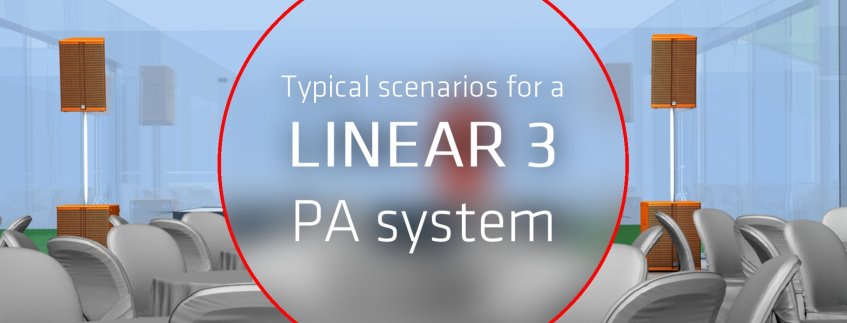How much PA do you need for your gig?
It is no great secret that most spaces in which bands perform are not designed to treat audiences to a glorious audio experience. Usually, the great attraction of smaller to medium-sized venues is their location or striking architecture rather than their wonderful acoustics. Generally speaking, the aspects of a room’s physics that influence a sound system’s performance are size, construction and the amount of reflections and reverberations caused by architecture such as parallel walls and smooth materials such as window glass and concrete. Sound engineers know how to set up a PA properly to tame these issues with room acoustics. Bands are another matter, though. Many musicians are interested in playing their instruments and little else. HK AUDIO has a solution for scenarios where a band has to get along without a sound engineer, LINEAR 3. This line of PA systems features smart DSP filtering that lets you get a handle on any room with just a few tweaks.
BAR

For acoustic performances in smaller, narrow bars and pubs with crowds of between 50 and 100 people, a balanced fullrange sound is required even without a subwoofer. For this example, an acoustic duo consisting of two singers and one acoustic guitar or keyboard performs on a 3.5 x 1.5 m stage platform. In small rooms, the duo can be sure that they will not invoke unwanted frequencies, even if they are not using equalizers.
Of course, proper placement also determines if the sonic treat that you serve up will be sweet or sour. We want to make it easier for you to achieve rich, sweet sound in various settings, so we’re going to take you through a few ideal situations. This goes to show you exactly what type of LINEAR 3 speaker you will need and what you will need it to do for you to cover the given venue. Having the right equipment at hand is no less important to your band than putting it in the right place.
LOBBY
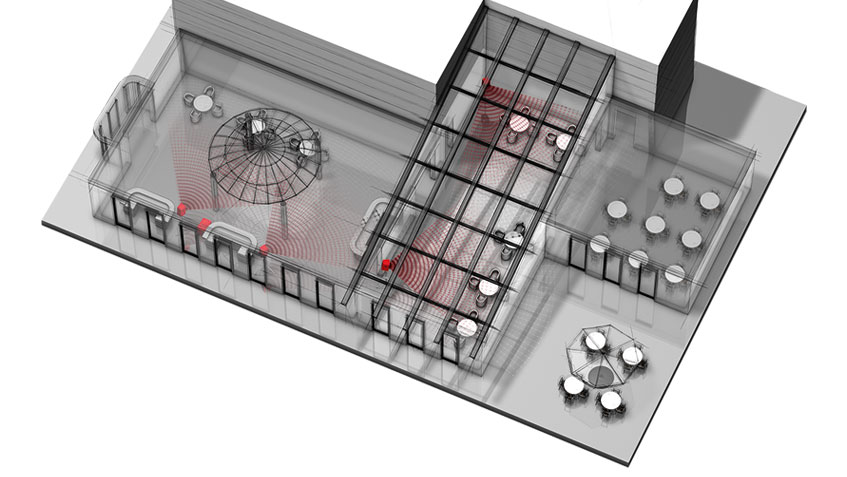
For events like receptions or the openings of new hotels, the mobile DJ often needs to cover a series of rooms (rather than just one), to crowds of between 100 and 150 people. The DJ controls the PA in the 15 x 10 m lobby and the neighboring 7 x 16 m lounge area directly from their decks. Both areas are supplied with an even fullrange sound at any volume level.
Getting your PA to cover the room:
Some basic rules always apply to all tips on placing speakers:
Horizontal directivity: It’s important to place the speakers so that you get a smooth transition from one speaker’s throw pattern to the next. You don’t want too much overlapping, nor any gaps. Get this right, and you systems will project your sound uniformly without interference across the entire frequency range.
Vertical directivity: If you have set of stacked speakers on the ground and are using a pole mount, make sure that the sound is not directed toward the audience’s feet or heads or the room’s ceilings or walls.
GALA
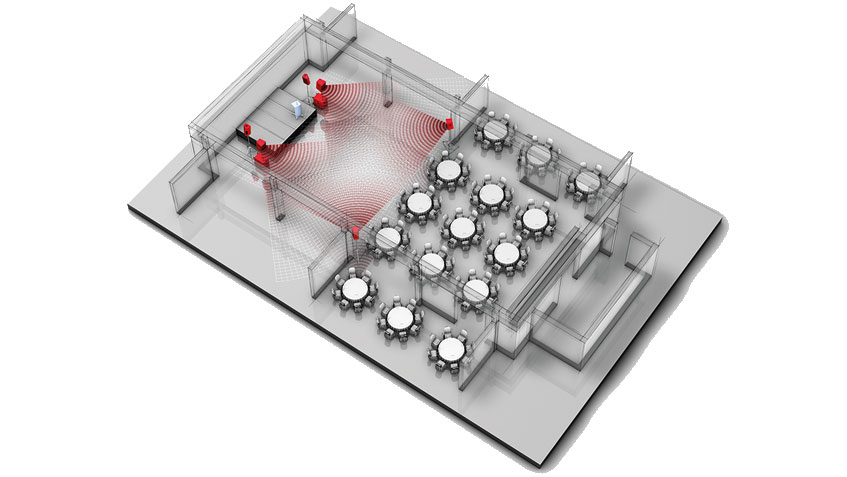
Weddings or gala events for between 150 and 350 guests require the PA to be split into two distinct sections: the dance floor and the dining area. In this example, a covers band (featuring drums, electric guitars and bass, vocals and a DJ) focuses its sound mainly on the dance floor from a 3 x 4 m stage area. The PA zones are divided into the following areas: The dance floor is comprehensively and optimally covered with deeper frequencies and, thanks to the additional 4-point sound system, has a disco-like feel. The dining area (organized in table groups) starts 7 m away from the Front PA and the background music level can be well regulated. The bar area offers ample opportunity for discussion.
You want to aim the speakers where you want your sound to go – towards to your audience’s ears. LINEAR 3 speakers can be aimed at two different angles using the DuoTilt pole mount. A slightly steeper downward angle on a pole mount directs the sound towards the audience and minimizes ceiling reflections. The general rule is the higher the speaker’s elevation, the steeper it should be angled down. This solution is a good way to go is cabinets are on a high stage or the room’s target area is very low, such as in cafés, small cellar clubs or conference buildings.
YOUTH CLUB
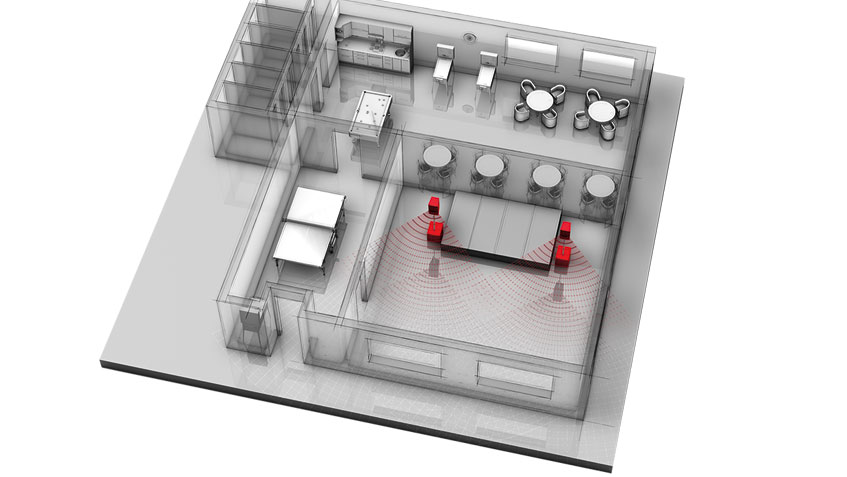
For youth center events, the PA system must be flexible enough to adapt to a wide variety of venue sizes and conditions, and crowd sizes of 150 to 300 listeners. The amateur rock band featured in this example is made up of two guitars, one bass, one drummer and one vocalist – they expect their PA to deliver a strong, assertive reproduction of their vocals and distorted guitar sounds. The PA, positioned at the side of the 2.5 x 4 m stage, delivers consistent sound dispersion across the entire 8 x 8 m room.
If you have a multifunctional enclosure like the L3 112 XA, you can turn it this way and that to flip the horizontal and vertical throw patterns. This can benefit your band: The L3 112 XA multipurpose speaker, for example, has a 3° installation angle and a horn with 90° x 55° directivity. Set at an up-angle for use as a monitor, its coverage pattern is 55° x 90°. This gives you a narrow beam with little or no overlap with other signal sources such as amps and microphones. The sound from the monitor does not swamp the entire stage; it targets and reaches only the one who needs it – unless of course you roam the stage far and wide. A narrow pattern also mitigates the risk of feedback somewhat. The 90° vertical directivity lets you move freely from the front to the back of the stage within your zone. If you’re a vocalist, you can stand on top of the cab and hear the monitor mix well. Move back a few meters to area of the stage where the drums usually go, and you will get the same clear signal.
MARQUEE
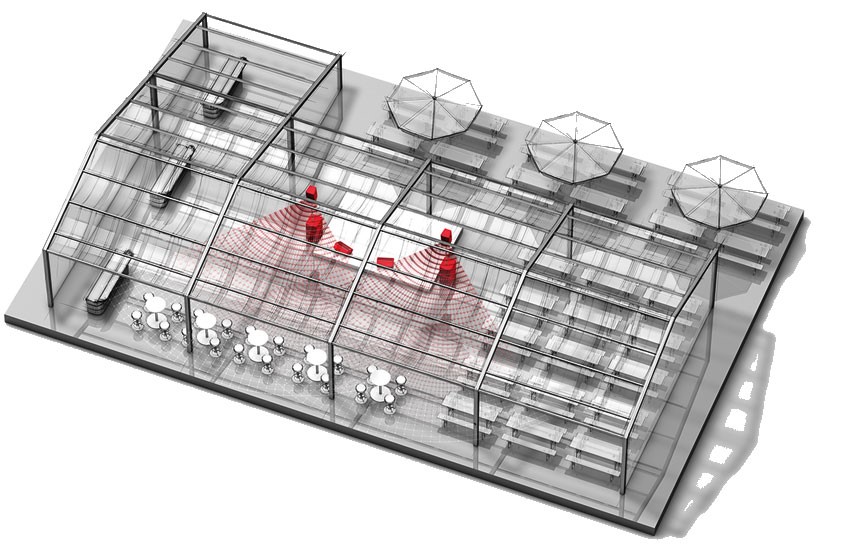
Events in smaller marquees often offer no suspension points to optimize the sound distribution over the area that needs to be covered. In this situation, the only reasonable acoustic solution is a professionally stacked PA, as such tents typically require different volume levels in different areas for between 250 and 400 attendees. For this example, the stage area is at ground level, 3 x 4 m in size and set up for a trio consisting of a vocalist, keyboard player and guitarist. The PA zones are divided into the following areas: The 6 x 10 m dance floor is wider than it is long, and the sound distribution covers the whole area extremely well, right up to the edge of the stage itself. The seating and bar areas are largely outside of the horizontal sound transmission angle, giving attendees the chance to hear the music and their own conversations without issue.
In most situations, a PA consists of speakers placed on and in front of the stage. If the room has alcoves, nooks or some other layout with lots of corners, we recommend dividing it up into listening zones.
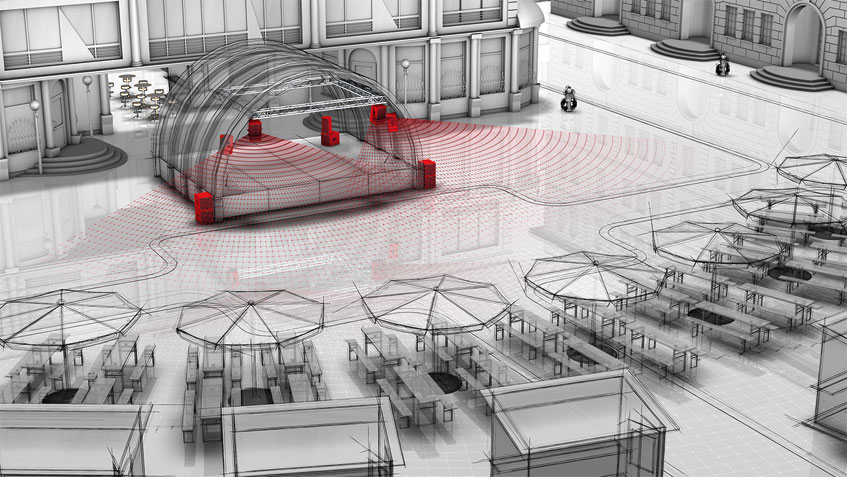
To get a better feeling for the size and the circumstances surrounding the venue, please check out the renderings in 3-D.


